Asset Management - Overview of RMC strategies
VerifiedAdded on 2022/09/15
|16
|3398
|14
AI Summary
Contribute Materials
Your contribution can guide someone’s learning journey. Share your
documents today.

Running Header: Asset Management 1
Topic: Asset Management
Student name:
Institution name:
Author:
Topic: Asset Management
Student name:
Institution name:
Author:
Secure Best Marks with AI Grader
Need help grading? Try our AI Grader for instant feedback on your assignments.
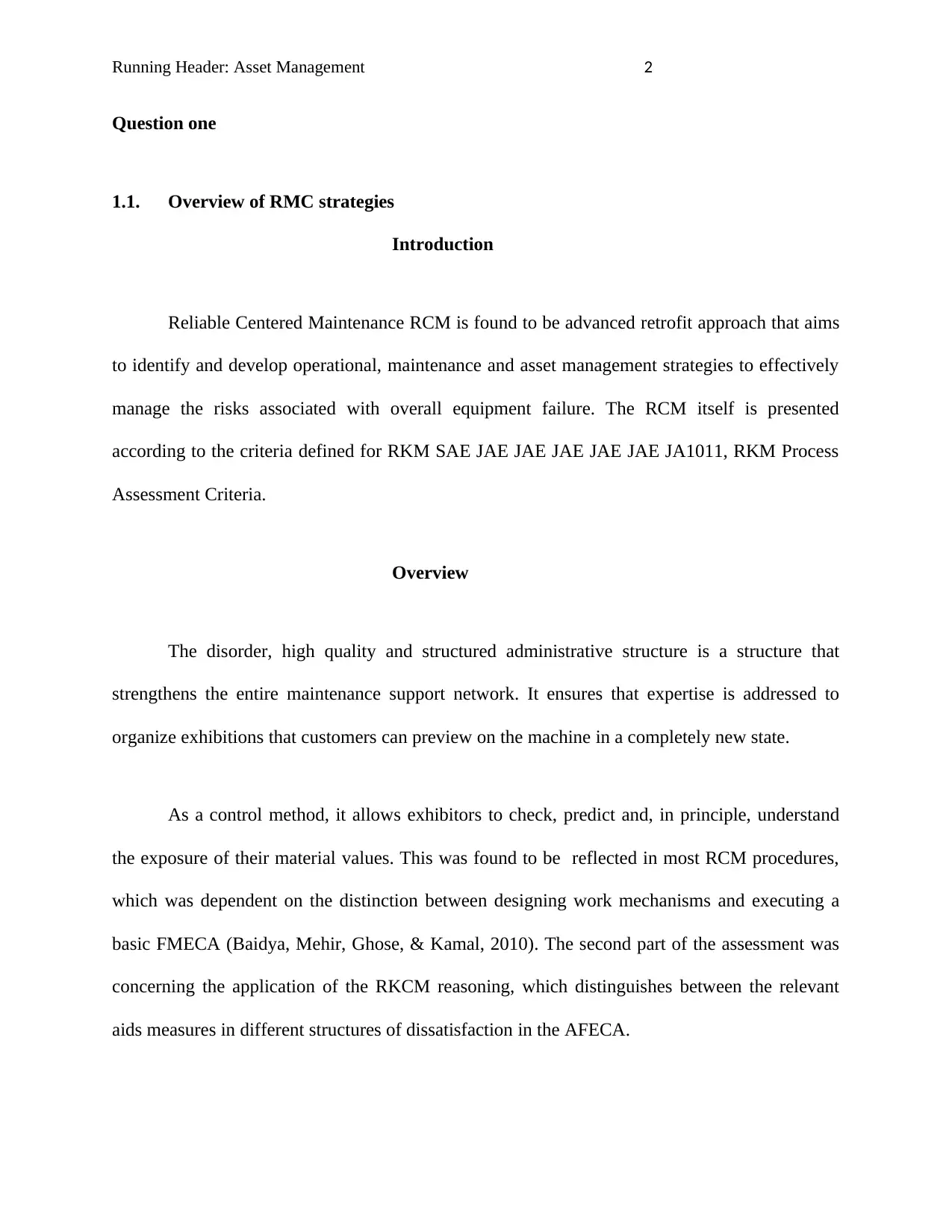
Running Header: Asset Management 2
Question one
1.1. Overview of RMC strategies
Introduction
Reliable Centered Maintenance RCM is found to be advanced retrofit approach that aims
to identify and develop operational, maintenance and asset management strategies to effectively
manage the risks associated with overall equipment failure. The RCM itself is presented
according to the criteria defined for RKM SAE JAE JAE JAE JAE JAE JA1011, RKM Process
Assessment Criteria.
Overview
The disorder, high quality and structured administrative structure is a structure that
strengthens the entire maintenance support network. It ensures that expertise is addressed to
organize exhibitions that customers can preview on the machine in a completely new state.
As a control method, it allows exhibitors to check, predict and, in principle, understand
the exposure of their material values. This was found to be reflected in most RCM procedures,
which was dependent on the distinction between designing work mechanisms and executing a
basic FMECA (Baidya, Mehir, Ghose, & Kamal, 2010). The second part of the assessment was
concerning the application of the RKCM reasoning, which distinguishes between the relevant
aids measures in different structures of dissatisfaction in the AFECA.
Question one
1.1. Overview of RMC strategies
Introduction
Reliable Centered Maintenance RCM is found to be advanced retrofit approach that aims
to identify and develop operational, maintenance and asset management strategies to effectively
manage the risks associated with overall equipment failure. The RCM itself is presented
according to the criteria defined for RKM SAE JAE JAE JAE JAE JAE JA1011, RKM Process
Assessment Criteria.
Overview
The disorder, high quality and structured administrative structure is a structure that
strengthens the entire maintenance support network. It ensures that expertise is addressed to
organize exhibitions that customers can preview on the machine in a completely new state.
As a control method, it allows exhibitors to check, predict and, in principle, understand
the exposure of their material values. This was found to be reflected in most RCM procedures,
which was dependent on the distinction between designing work mechanisms and executing a
basic FMECA (Baidya, Mehir, Ghose, & Kamal, 2010). The second part of the assessment was
concerning the application of the RKCM reasoning, which distinguishes between the relevant
aids measures in different structures of dissatisfaction in the AFECA.
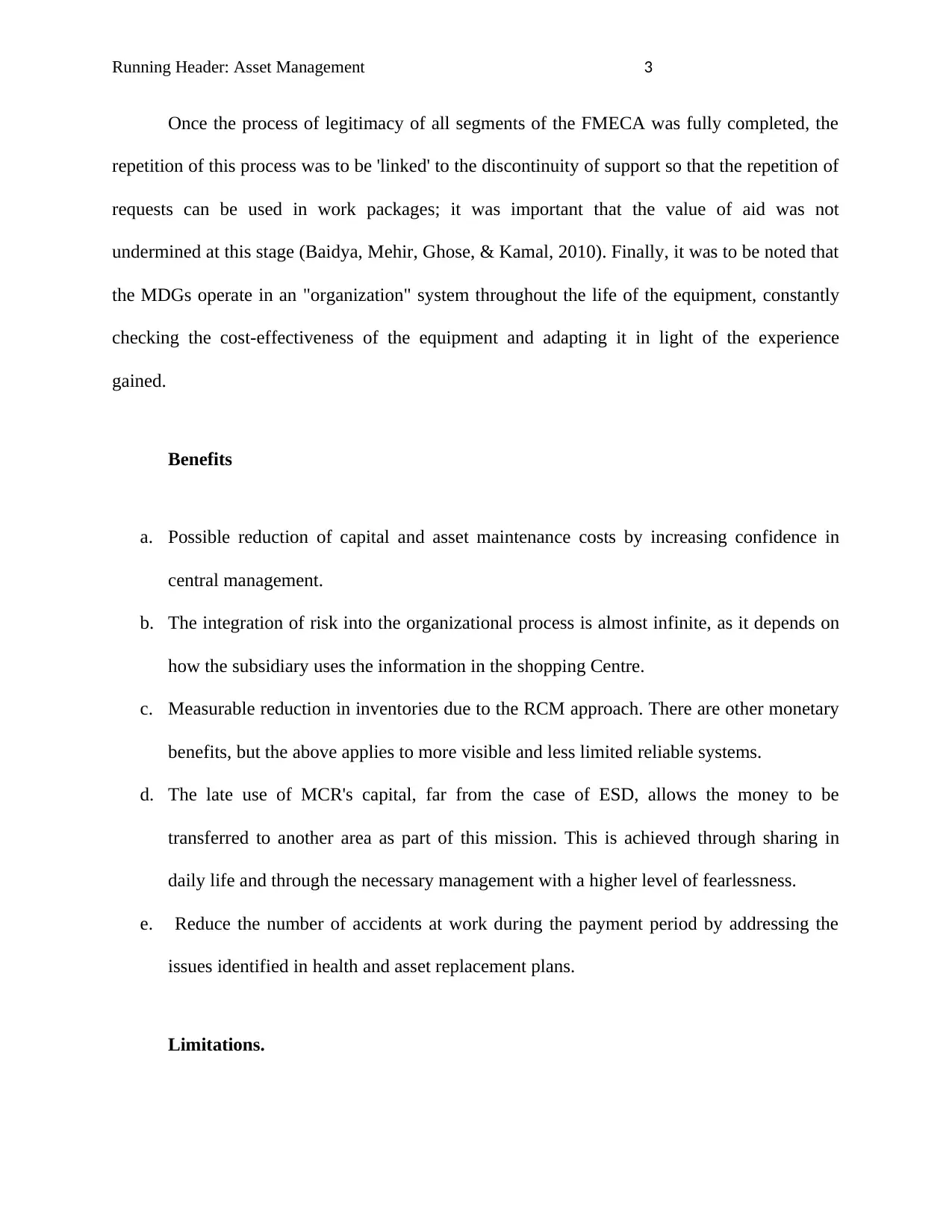
Running Header: Asset Management 3
Once the process of legitimacy of all segments of the FMECA was fully completed, the
repetition of this process was to be 'linked' to the discontinuity of support so that the repetition of
requests can be used in work packages; it was important that the value of aid was not
undermined at this stage (Baidya, Mehir, Ghose, & Kamal, 2010). Finally, it was to be noted that
the MDGs operate in an "organization" system throughout the life of the equipment, constantly
checking the cost-effectiveness of the equipment and adapting it in light of the experience
gained.
Benefits
a. Possible reduction of capital and asset maintenance costs by increasing confidence in
central management.
b. The integration of risk into the organizational process is almost infinite, as it depends on
how the subsidiary uses the information in the shopping Centre.
c. Measurable reduction in inventories due to the RCM approach. There are other monetary
benefits, but the above applies to more visible and less limited reliable systems.
d. The late use of MCR's capital, far from the case of ESD, allows the money to be
transferred to another area as part of this mission. This is achieved through sharing in
daily life and through the necessary management with a higher level of fearlessness.
e. Reduce the number of accidents at work during the payment period by addressing the
issues identified in health and asset replacement plans.
Limitations.
Once the process of legitimacy of all segments of the FMECA was fully completed, the
repetition of this process was to be 'linked' to the discontinuity of support so that the repetition of
requests can be used in work packages; it was important that the value of aid was not
undermined at this stage (Baidya, Mehir, Ghose, & Kamal, 2010). Finally, it was to be noted that
the MDGs operate in an "organization" system throughout the life of the equipment, constantly
checking the cost-effectiveness of the equipment and adapting it in light of the experience
gained.
Benefits
a. Possible reduction of capital and asset maintenance costs by increasing confidence in
central management.
b. The integration of risk into the organizational process is almost infinite, as it depends on
how the subsidiary uses the information in the shopping Centre.
c. Measurable reduction in inventories due to the RCM approach. There are other monetary
benefits, but the above applies to more visible and less limited reliable systems.
d. The late use of MCR's capital, far from the case of ESD, allows the money to be
transferred to another area as part of this mission. This is achieved through sharing in
daily life and through the necessary management with a higher level of fearlessness.
e. Reduce the number of accidents at work during the payment period by addressing the
issues identified in health and asset replacement plans.
Limitations.
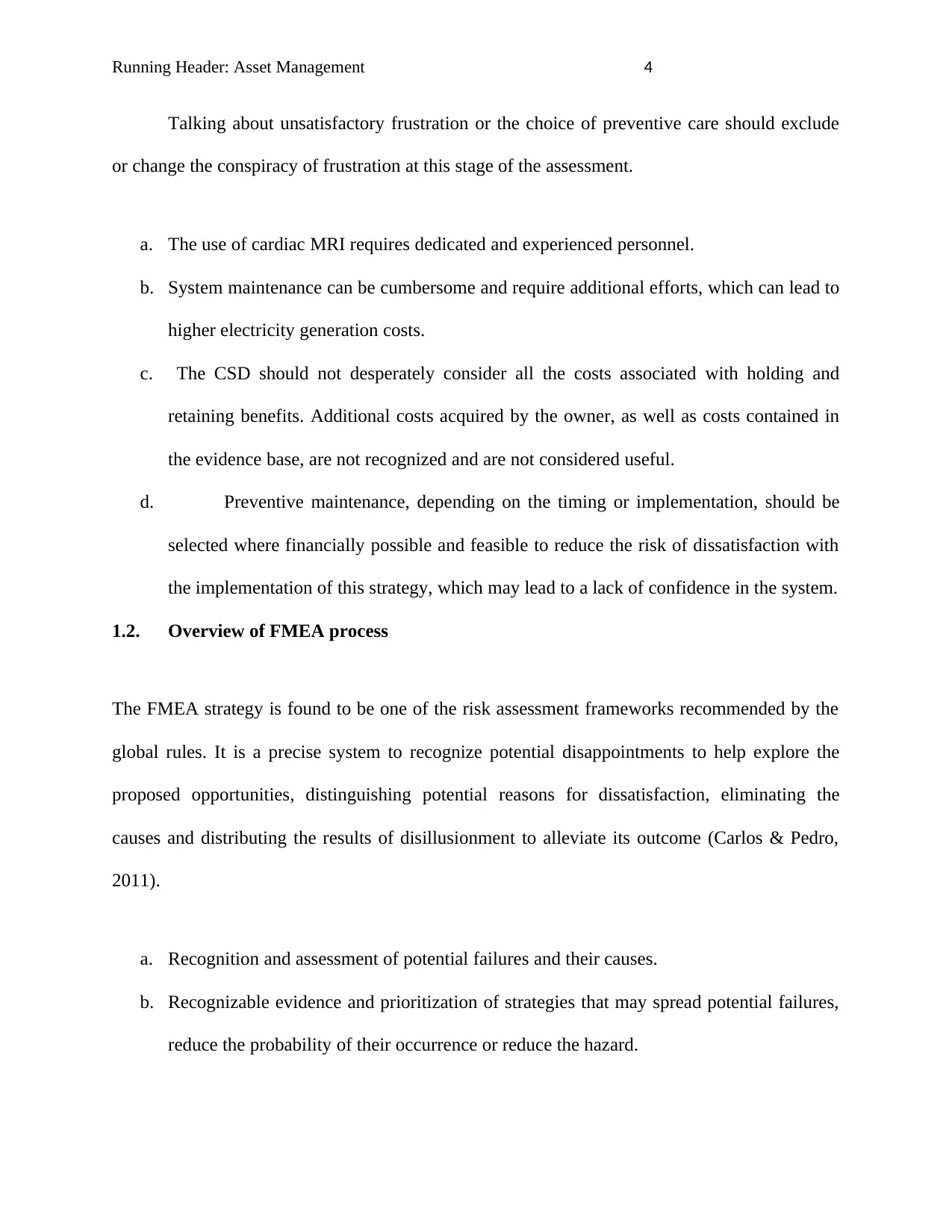
Running Header: Asset Management 4
Talking about unsatisfactory frustration or the choice of preventive care should exclude
or change the conspiracy of frustration at this stage of the assessment.
a. The use of cardiac MRI requires dedicated and experienced personnel.
b. System maintenance can be cumbersome and require additional efforts, which can lead to
higher electricity generation costs.
c. The CSD should not desperately consider all the costs associated with holding and
retaining benefits. Additional costs acquired by the owner, as well as costs contained in
the evidence base, are not recognized and are not considered useful.
d. Preventive maintenance, depending on the timing or implementation, should be
selected where financially possible and feasible to reduce the risk of dissatisfaction with
the implementation of this strategy, which may lead to a lack of confidence in the system.
1.2. Overview of FMEA process
The FMEA strategy is found to be one of the risk assessment frameworks recommended by the
global rules. It is a precise system to recognize potential disappointments to help explore the
proposed opportunities, distinguishing potential reasons for dissatisfaction, eliminating the
causes and distributing the results of disillusionment to alleviate its outcome (Carlos & Pedro,
2011).
a. Recognition and assessment of potential failures and their causes.
b. Recognizable evidence and prioritization of strategies that may spread potential failures,
reduce the probability of their occurrence or reduce the hazard.
Talking about unsatisfactory frustration or the choice of preventive care should exclude
or change the conspiracy of frustration at this stage of the assessment.
a. The use of cardiac MRI requires dedicated and experienced personnel.
b. System maintenance can be cumbersome and require additional efforts, which can lead to
higher electricity generation costs.
c. The CSD should not desperately consider all the costs associated with holding and
retaining benefits. Additional costs acquired by the owner, as well as costs contained in
the evidence base, are not recognized and are not considered useful.
d. Preventive maintenance, depending on the timing or implementation, should be
selected where financially possible and feasible to reduce the risk of dissatisfaction with
the implementation of this strategy, which may lead to a lack of confidence in the system.
1.2. Overview of FMEA process
The FMEA strategy is found to be one of the risk assessment frameworks recommended by the
global rules. It is a precise system to recognize potential disappointments to help explore the
proposed opportunities, distinguishing potential reasons for dissatisfaction, eliminating the
causes and distributing the results of disillusionment to alleviate its outcome (Carlos & Pedro,
2011).
a. Recognition and assessment of potential failures and their causes.
b. Recognizable evidence and prioritization of strategies that may spread potential failures,
reduce the probability of their occurrence or reduce the hazard.
Secure Best Marks with AI Grader
Need help grading? Try our AI Grader for instant feedback on your assignments.

Running Header: Asset Management 5
c. Documentation of average testing, assessment and recovery activities to improve the
quality of the item after some time.
FMEA and risk assessment
The FMEA is found to be one of the few risk screening strategies. A risk analysis is a resolved
method that decides both the probability of an unexpected event (failure) and the degree of the
negative results of the occasion and then provides a conceivable response to this survey. Despite
small-scale organizations (SMEs), there are different strategies for exploiting hazards (Carsten &
Peter, 2009).
FMEA Coordinators
By applying the PMEA technique to the different life cycles of an item, this methodology
provides a weighted method prepared to analyze all the ways in which an item may fall
(Minnaard & H., 2013).
Benefits
a. Helps characterize the prerequisites for choosing materials, parts, gadgets, sections and orders.
b. Helps characterize the objectives behind the changes.
d. Provides coordination of specialized strategies between multiple units.
c. Documentation of average testing, assessment and recovery activities to improve the
quality of the item after some time.
FMEA and risk assessment
The FMEA is found to be one of the few risk screening strategies. A risk analysis is a resolved
method that decides both the probability of an unexpected event (failure) and the degree of the
negative results of the occasion and then provides a conceivable response to this survey. Despite
small-scale organizations (SMEs), there are different strategies for exploiting hazards (Carsten &
Peter, 2009).
FMEA Coordinators
By applying the PMEA technique to the different life cycles of an item, this methodology
provides a weighted method prepared to analyze all the ways in which an item may fall
(Minnaard & H., 2013).
Benefits
a. Helps characterize the prerequisites for choosing materials, parts, gadgets, sections and orders.
b. Helps characterize the objectives behind the changes.
d. Provides coordination of specialized strategies between multiple units.
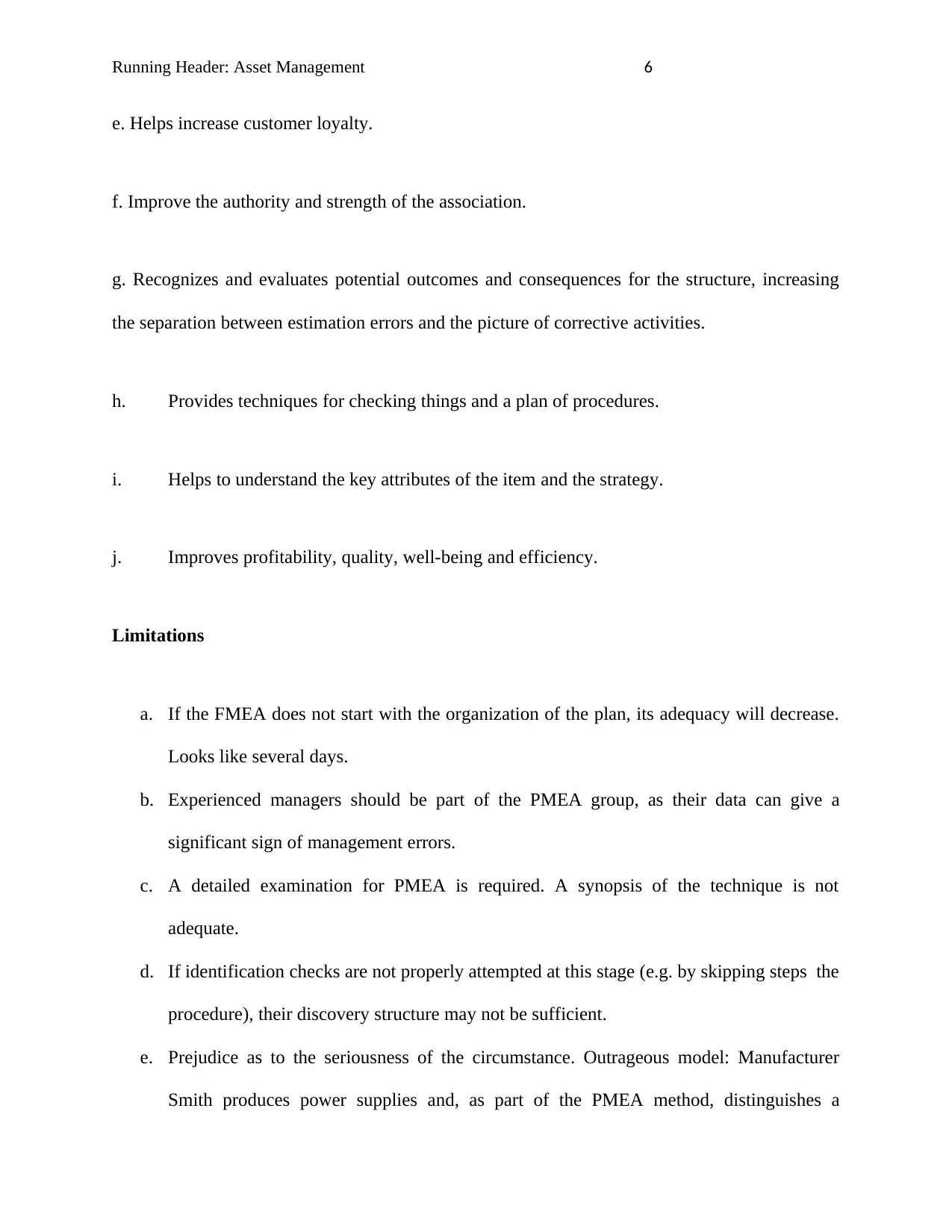
Running Header: Asset Management 6
e. Helps increase customer loyalty.
f. Improve the authority and strength of the association.
g. Recognizes and evaluates potential outcomes and consequences for the structure, increasing
the separation between estimation errors and the picture of corrective activities.
h. Provides techniques for checking things and a plan of procedures.
i. Helps to understand the key attributes of the item and the strategy.
j. Improves profitability, quality, well-being and efficiency.
Limitations
a. If the FMEA does not start with the organization of the plan, its adequacy will decrease.
Looks like several days.
b. Experienced managers should be part of the PMEA group, as their data can give a
significant sign of management errors.
c. A detailed examination for PMEA is required. A synopsis of the technique is not
adequate.
d. If identification checks are not properly attempted at this stage (e.g. by skipping steps the
procedure), their discovery structure may not be sufficient.
e. Prejudice as to the seriousness of the circumstance. Outrageous model: Manufacturer
Smith produces power supplies and, as part of the PMEA method, distinguishes a
e. Helps increase customer loyalty.
f. Improve the authority and strength of the association.
g. Recognizes and evaluates potential outcomes and consequences for the structure, increasing
the separation between estimation errors and the picture of corrective activities.
h. Provides techniques for checking things and a plan of procedures.
i. Helps to understand the key attributes of the item and the strategy.
j. Improves profitability, quality, well-being and efficiency.
Limitations
a. If the FMEA does not start with the organization of the plan, its adequacy will decrease.
Looks like several days.
b. Experienced managers should be part of the PMEA group, as their data can give a
significant sign of management errors.
c. A detailed examination for PMEA is required. A synopsis of the technique is not
adequate.
d. If identification checks are not properly attempted at this stage (e.g. by skipping steps the
procedure), their discovery structure may not be sufficient.
e. Prejudice as to the seriousness of the circumstance. Outrageous model: Manufacturer
Smith produces power supplies and, as part of the PMEA method, distinguishes a
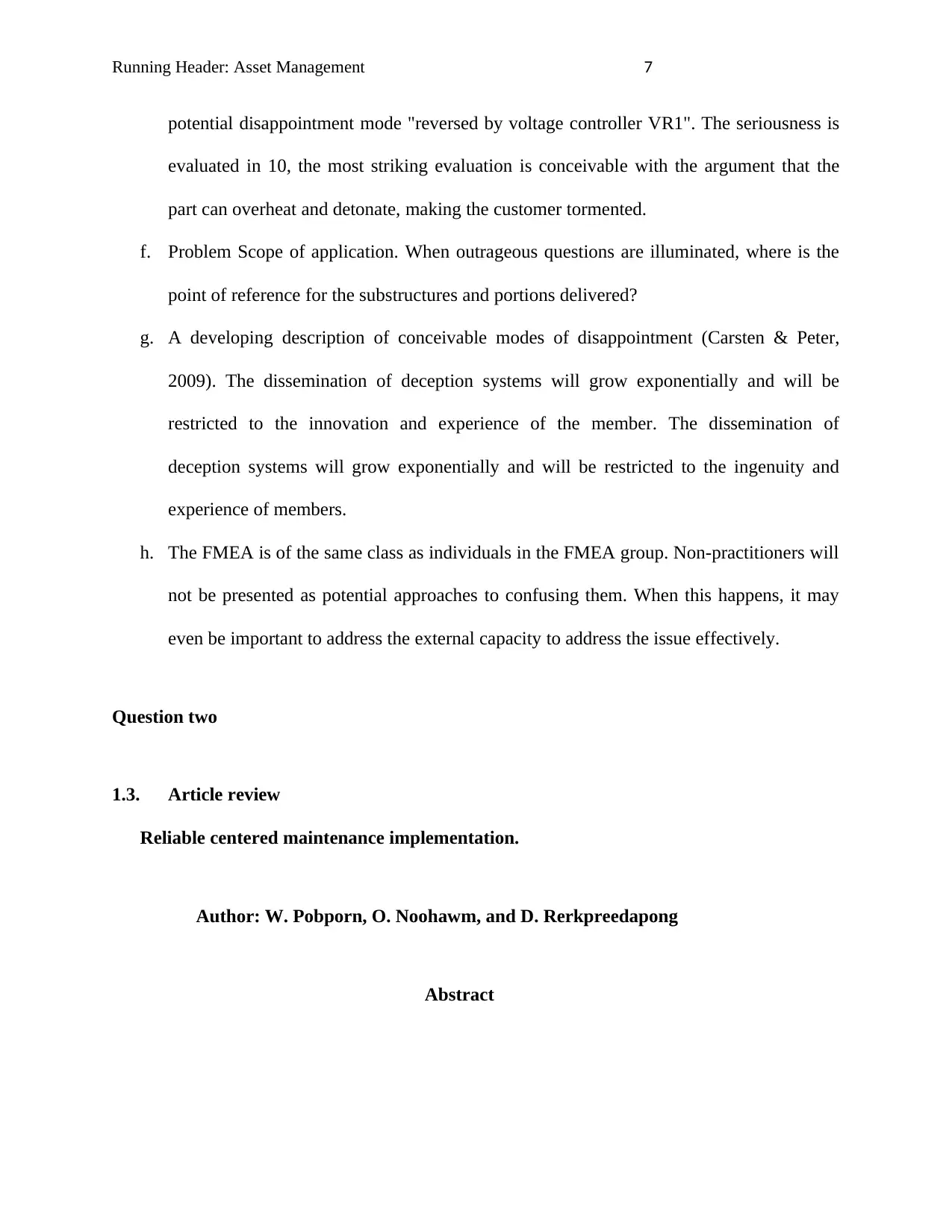
Running Header: Asset Management 7
potential disappointment mode "reversed by voltage controller VR1". The seriousness is
evaluated in 10, the most striking evaluation is conceivable with the argument that the
part can overheat and detonate, making the customer tormented.
f. Problem Scope of application. When outrageous questions are illuminated, where is the
point of reference for the substructures and portions delivered?
g. A developing description of conceivable modes of disappointment (Carsten & Peter,
2009). The dissemination of deception systems will grow exponentially and will be
restricted to the innovation and experience of the member. The dissemination of
deception systems will grow exponentially and will be restricted to the ingenuity and
experience of members.
h. The FMEA is of the same class as individuals in the FMEA group. Non-practitioners will
not be presented as potential approaches to confusing them. When this happens, it may
even be important to address the external capacity to address the issue effectively.
Question two
1.3. Article review
Reliable centered maintenance implementation.
Author: W. Pobporn, O. Noohawm, and D. Rerkpreedapong
Abstract
potential disappointment mode "reversed by voltage controller VR1". The seriousness is
evaluated in 10, the most striking evaluation is conceivable with the argument that the
part can overheat and detonate, making the customer tormented.
f. Problem Scope of application. When outrageous questions are illuminated, where is the
point of reference for the substructures and portions delivered?
g. A developing description of conceivable modes of disappointment (Carsten & Peter,
2009). The dissemination of deception systems will grow exponentially and will be
restricted to the innovation and experience of the member. The dissemination of
deception systems will grow exponentially and will be restricted to the ingenuity and
experience of members.
h. The FMEA is of the same class as individuals in the FMEA group. Non-practitioners will
not be presented as potential approaches to confusing them. When this happens, it may
even be important to address the external capacity to address the issue effectively.
Question two
1.3. Article review
Reliable centered maintenance implementation.
Author: W. Pobporn, O. Noohawm, and D. Rerkpreedapong
Abstract
Paraphrase This Document
Need a fresh take? Get an instant paraphrase of this document with our AI Paraphraser
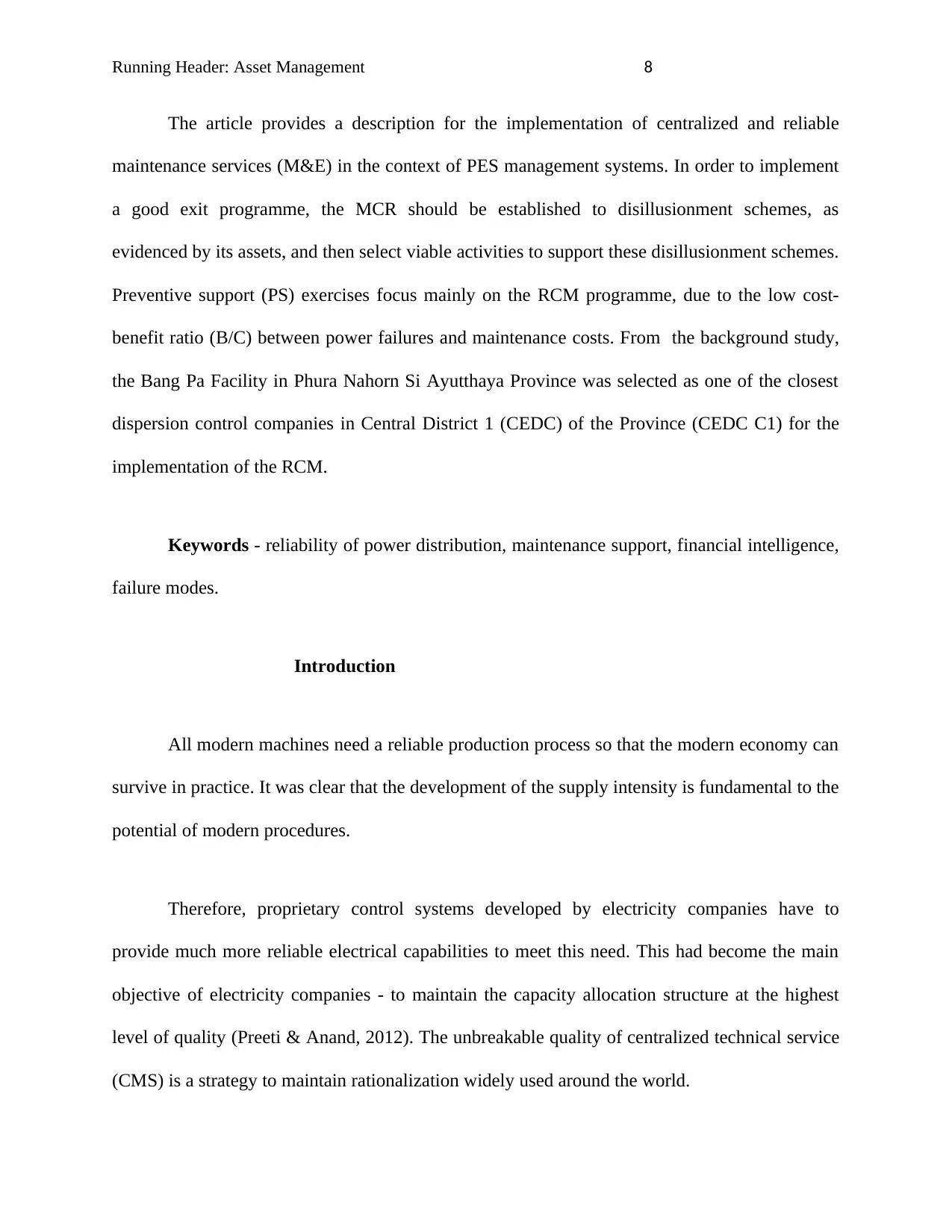
Running Header: Asset Management 8
The article provides a description for the implementation of centralized and reliable
maintenance services (M&E) in the context of PES management systems. In order to implement
a good exit programme, the MCR should be established to disillusionment schemes, as
evidenced by its assets, and then select viable activities to support these disillusionment schemes.
Preventive support (PS) exercises focus mainly on the RCM programme, due to the low cost-
benefit ratio (B/C) between power failures and maintenance costs. From the background study,
the Bang Pa Facility in Phura Nahorn Si Ayutthaya Province was selected as one of the closest
dispersion control companies in Central District 1 (CEDC) of the Province (CEDC C1) for the
implementation of the RCM.
Keywords - reliability of power distribution, maintenance support, financial intelligence,
failure modes.
Introduction
All modern machines need a reliable production process so that the modern economy can
survive in practice. It was clear that the development of the supply intensity is fundamental to the
potential of modern procedures.
Therefore, proprietary control systems developed by electricity companies have to
provide much more reliable electrical capabilities to meet this need. This had become the main
objective of electricity companies - to maintain the capacity allocation structure at the highest
level of quality (Preeti & Anand, 2012). The unbreakable quality of centralized technical service
(CMS) is a strategy to maintain rationalization widely used around the world.
The article provides a description for the implementation of centralized and reliable
maintenance services (M&E) in the context of PES management systems. In order to implement
a good exit programme, the MCR should be established to disillusionment schemes, as
evidenced by its assets, and then select viable activities to support these disillusionment schemes.
Preventive support (PS) exercises focus mainly on the RCM programme, due to the low cost-
benefit ratio (B/C) between power failures and maintenance costs. From the background study,
the Bang Pa Facility in Phura Nahorn Si Ayutthaya Province was selected as one of the closest
dispersion control companies in Central District 1 (CEDC) of the Province (CEDC C1) for the
implementation of the RCM.
Keywords - reliability of power distribution, maintenance support, financial intelligence,
failure modes.
Introduction
All modern machines need a reliable production process so that the modern economy can
survive in practice. It was clear that the development of the supply intensity is fundamental to the
potential of modern procedures.
Therefore, proprietary control systems developed by electricity companies have to
provide much more reliable electrical capabilities to meet this need. This had become the main
objective of electricity companies - to maintain the capacity allocation structure at the highest
level of quality (Preeti & Anand, 2012). The unbreakable quality of centralized technical service
(CMS) is a strategy to maintain rationalization widely used around the world.
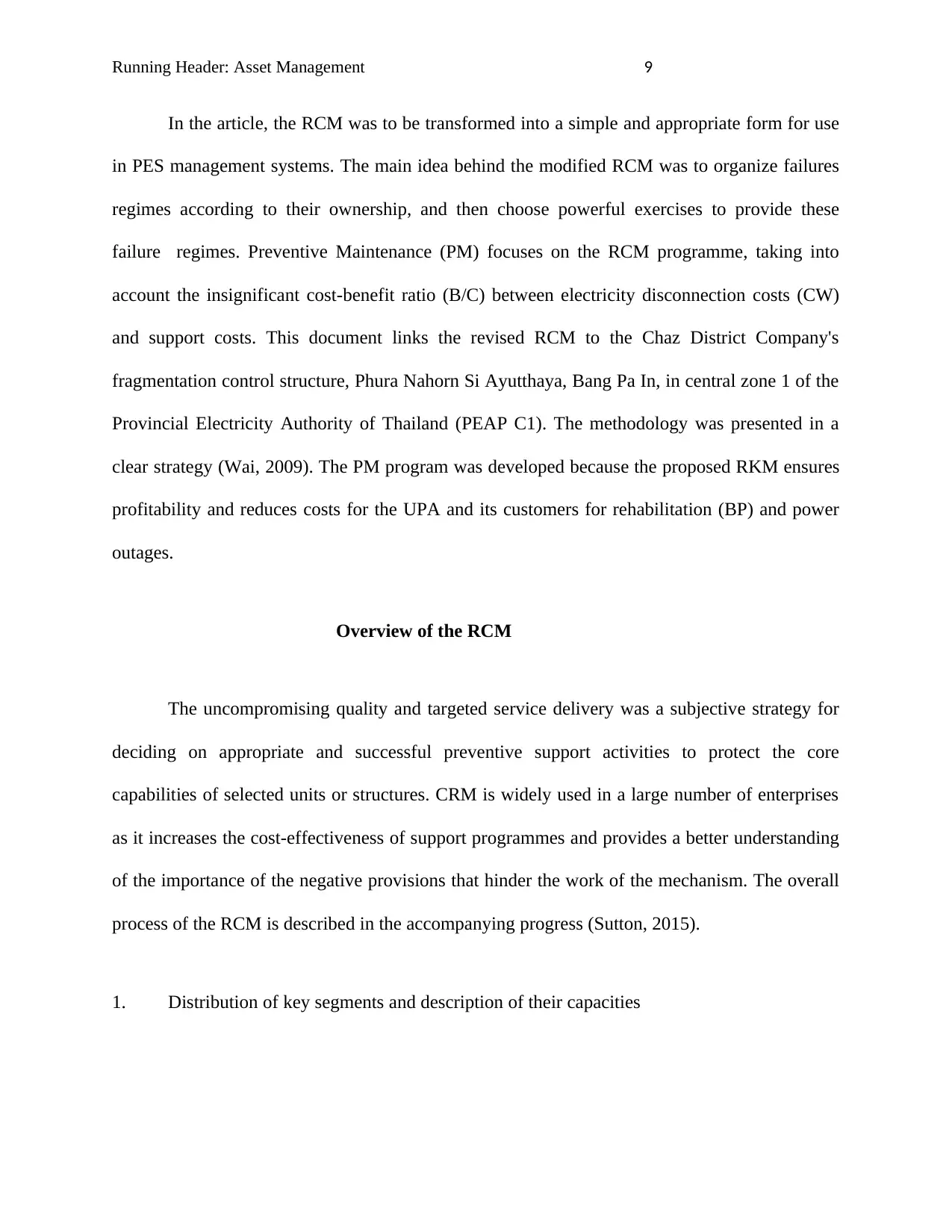
Running Header: Asset Management 9
In the article, the RCM was to be transformed into a simple and appropriate form for use
in PES management systems. The main idea behind the modified RCM was to organize failures
regimes according to their ownership, and then choose powerful exercises to provide these
failure regimes. Preventive Maintenance (PM) focuses on the RCM programme, taking into
account the insignificant cost-benefit ratio (B/C) between electricity disconnection costs (CW)
and support costs. This document links the revised RCM to the Chaz District Company's
fragmentation control structure, Phura Nahorn Si Ayutthaya, Bang Pa In, in central zone 1 of the
Provincial Electricity Authority of Thailand (PEAP C1). The methodology was presented in a
clear strategy (Wai, 2009). The PM program was developed because the proposed RKM ensures
profitability and reduces costs for the UPA and its customers for rehabilitation (BP) and power
outages.
Overview of the RCM
The uncompromising quality and targeted service delivery was a subjective strategy for
deciding on appropriate and successful preventive support activities to protect the core
capabilities of selected units or structures. CRM is widely used in a large number of enterprises
as it increases the cost-effectiveness of support programmes and provides a better understanding
of the importance of the negative provisions that hinder the work of the mechanism. The overall
process of the RCM is described in the accompanying progress (Sutton, 2015).
1. Distribution of key segments and description of their capacities
In the article, the RCM was to be transformed into a simple and appropriate form for use
in PES management systems. The main idea behind the modified RCM was to organize failures
regimes according to their ownership, and then choose powerful exercises to provide these
failure regimes. Preventive Maintenance (PM) focuses on the RCM programme, taking into
account the insignificant cost-benefit ratio (B/C) between electricity disconnection costs (CW)
and support costs. This document links the revised RCM to the Chaz District Company's
fragmentation control structure, Phura Nahorn Si Ayutthaya, Bang Pa In, in central zone 1 of the
Provincial Electricity Authority of Thailand (PEAP C1). The methodology was presented in a
clear strategy (Wai, 2009). The PM program was developed because the proposed RKM ensures
profitability and reduces costs for the UPA and its customers for rehabilitation (BP) and power
outages.
Overview of the RCM
The uncompromising quality and targeted service delivery was a subjective strategy for
deciding on appropriate and successful preventive support activities to protect the core
capabilities of selected units or structures. CRM is widely used in a large number of enterprises
as it increases the cost-effectiveness of support programmes and provides a better understanding
of the importance of the negative provisions that hinder the work of the mechanism. The overall
process of the RCM is described in the accompanying progress (Sutton, 2015).
1. Distribution of key segments and description of their capacities
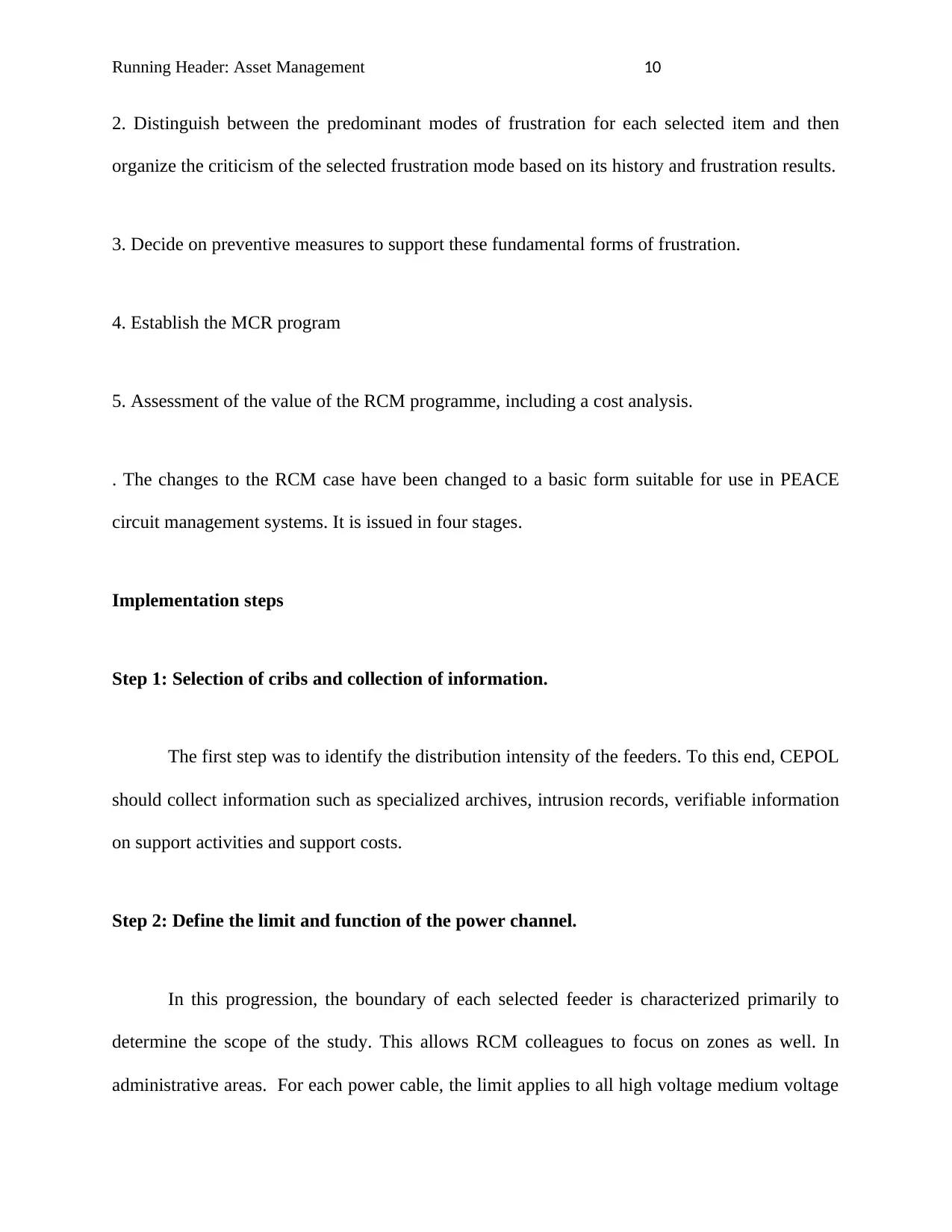
Running Header: Asset Management 10
2. Distinguish between the predominant modes of frustration for each selected item and then
organize the criticism of the selected frustration mode based on its history and frustration results.
3. Decide on preventive measures to support these fundamental forms of frustration.
4. Establish the MCR program
5. Assessment of the value of the RCM programme, including a cost analysis.
. The changes to the RCM case have been changed to a basic form suitable for use in PEACE
circuit management systems. It is issued in four stages.
Implementation steps
Step 1: Selection of cribs and collection of information.
The first step was to identify the distribution intensity of the feeders. To this end, CEPOL
should collect information such as specialized archives, intrusion records, verifiable information
on support activities and support costs.
Step 2: Define the limit and function of the power channel.
In this progression, the boundary of each selected feeder is characterized primarily to
determine the scope of the study. This allows RCM colleagues to focus on zones as well. In
administrative areas. For each power cable, the limit applies to all high voltage medium voltage
2. Distinguish between the predominant modes of frustration for each selected item and then
organize the criticism of the selected frustration mode based on its history and frustration results.
3. Decide on preventive measures to support these fundamental forms of frustration.
4. Establish the MCR program
5. Assessment of the value of the RCM programme, including a cost analysis.
. The changes to the RCM case have been changed to a basic form suitable for use in PEACE
circuit management systems. It is issued in four stages.
Implementation steps
Step 1: Selection of cribs and collection of information.
The first step was to identify the distribution intensity of the feeders. To this end, CEPOL
should collect information such as specialized archives, intrusion records, verifiable information
on support activities and support costs.
Step 2: Define the limit and function of the power channel.
In this progression, the boundary of each selected feeder is characterized primarily to
determine the scope of the study. This allows RCM colleagues to focus on zones as well. In
administrative areas. For each power cable, the limit applies to all high voltage medium voltage
Secure Best Marks with AI Grader
Need help grading? Try our AI Grader for instant feedback on your assignments.
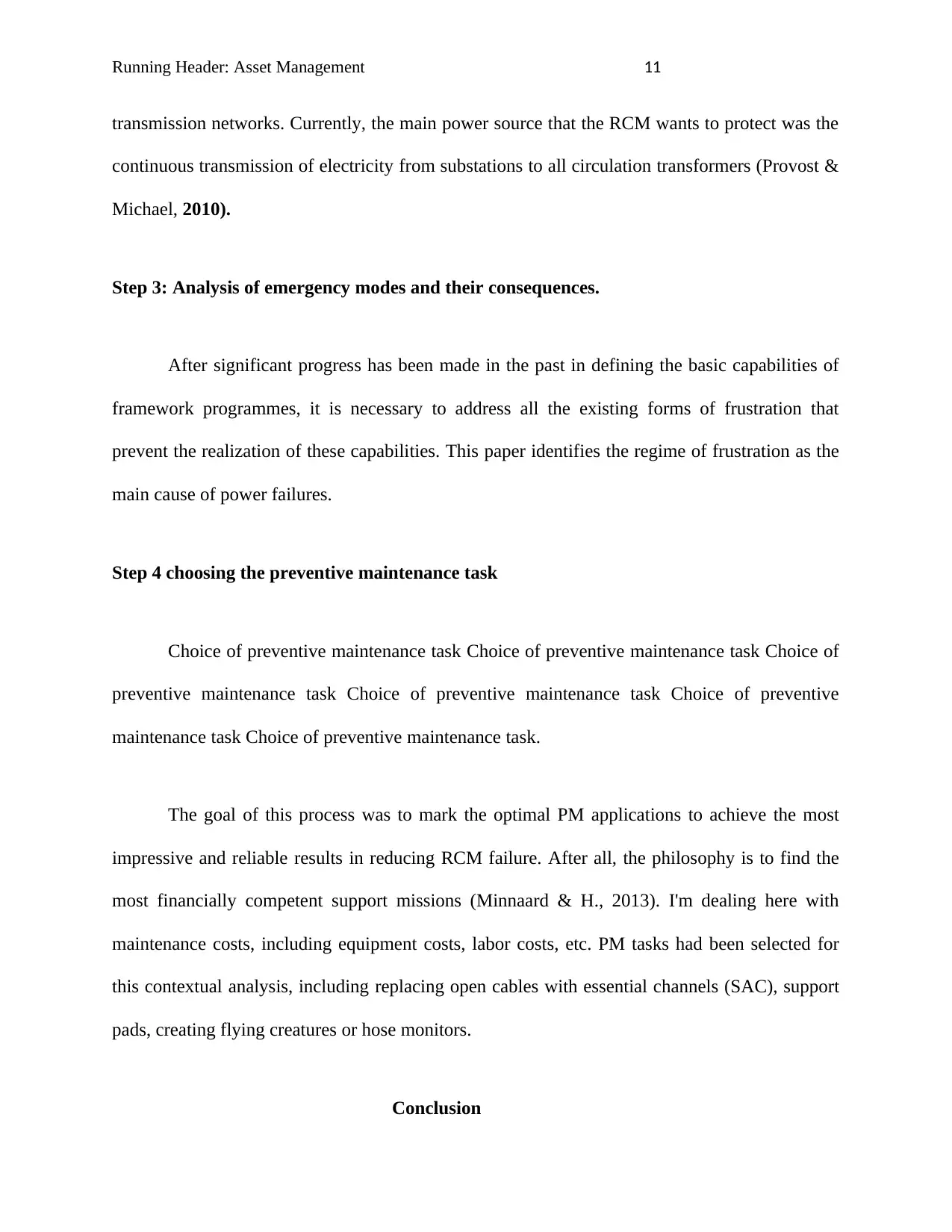
Running Header: Asset Management 11
transmission networks. Currently, the main power source that the RCM wants to protect was the
continuous transmission of electricity from substations to all circulation transformers (Provost &
Michael, 2010).
Step 3: Analysis of emergency modes and their consequences.
After significant progress has been made in the past in defining the basic capabilities of
framework programmes, it is necessary to address all the existing forms of frustration that
prevent the realization of these capabilities. This paper identifies the regime of frustration as the
main cause of power failures.
Step 4 choosing the preventive maintenance task
Choice of preventive maintenance task Choice of preventive maintenance task Choice of
preventive maintenance task Choice of preventive maintenance task Choice of preventive
maintenance task Choice of preventive maintenance task.
The goal of this process was to mark the optimal PM applications to achieve the most
impressive and reliable results in reducing RCM failure. After all, the philosophy is to find the
most financially competent support missions (Minnaard & H., 2013). I'm dealing here with
maintenance costs, including equipment costs, labor costs, etc. PM tasks had been selected for
this contextual analysis, including replacing open cables with essential channels (SAC), support
pads, creating flying creatures or hose monitors.
Conclusion
transmission networks. Currently, the main power source that the RCM wants to protect was the
continuous transmission of electricity from substations to all circulation transformers (Provost &
Michael, 2010).
Step 3: Analysis of emergency modes and their consequences.
After significant progress has been made in the past in defining the basic capabilities of
framework programmes, it is necessary to address all the existing forms of frustration that
prevent the realization of these capabilities. This paper identifies the regime of frustration as the
main cause of power failures.
Step 4 choosing the preventive maintenance task
Choice of preventive maintenance task Choice of preventive maintenance task Choice of
preventive maintenance task Choice of preventive maintenance task Choice of preventive
maintenance task Choice of preventive maintenance task.
The goal of this process was to mark the optimal PM applications to achieve the most
impressive and reliable results in reducing RCM failure. After all, the philosophy is to find the
most financially competent support missions (Minnaard & H., 2013). I'm dealing here with
maintenance costs, including equipment costs, labor costs, etc. PM tasks had been selected for
this contextual analysis, including replacing open cables with essential channels (SAC), support
pads, creating flying creatures or hose monitors.
Conclusion
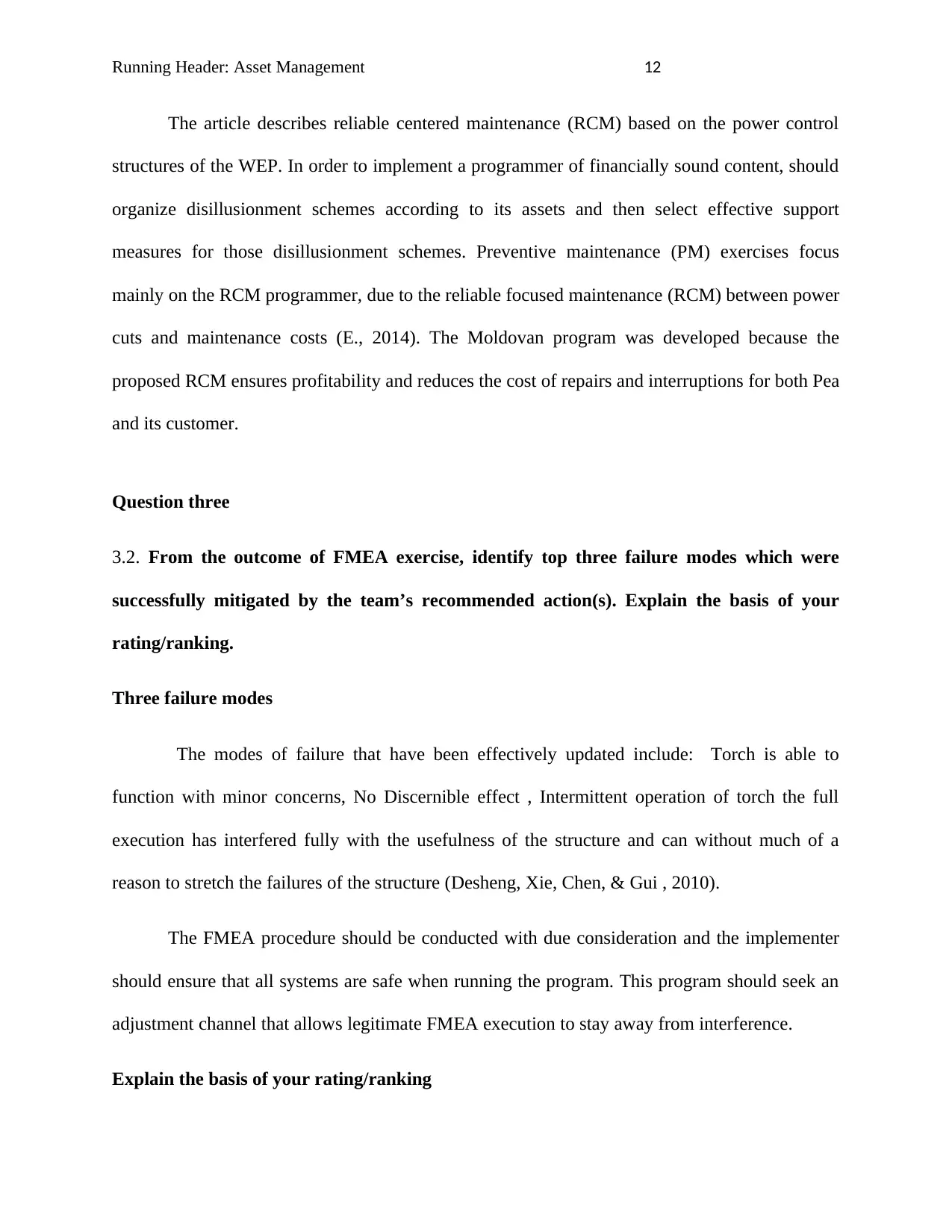
Running Header: Asset Management 12
The article describes reliable centered maintenance (RCM) based on the power control
structures of the WEP. In order to implement a programmer of financially sound content, should
organize disillusionment schemes according to its assets and then select effective support
measures for those disillusionment schemes. Preventive maintenance (PM) exercises focus
mainly on the RCM programmer, due to the reliable focused maintenance (RCM) between power
cuts and maintenance costs (E., 2014). The Moldovan program was developed because the
proposed RCM ensures profitability and reduces the cost of repairs and interruptions for both Pea
and its customer.
Question three
3.2. From the outcome of FMEA exercise, identify top three failure modes which were
successfully mitigated by the team’s recommended action(s). Explain the basis of your
rating/ranking.
Three failure modes
The modes of failure that have been effectively updated include: Torch is able to
function with minor concerns, No Discernible effect , Intermittent operation of torch the full
execution has interfered fully with the usefulness of the structure and can without much of a
reason to stretch the failures of the structure (Desheng, Xie, Chen, & Gui , 2010).
The FMEA procedure should be conducted with due consideration and the implementer
should ensure that all systems are safe when running the program. This program should seek an
adjustment channel that allows legitimate FMEA execution to stay away from interference.
Explain the basis of your rating/ranking
The article describes reliable centered maintenance (RCM) based on the power control
structures of the WEP. In order to implement a programmer of financially sound content, should
organize disillusionment schemes according to its assets and then select effective support
measures for those disillusionment schemes. Preventive maintenance (PM) exercises focus
mainly on the RCM programmer, due to the reliable focused maintenance (RCM) between power
cuts and maintenance costs (E., 2014). The Moldovan program was developed because the
proposed RCM ensures profitability and reduces the cost of repairs and interruptions for both Pea
and its customer.
Question three
3.2. From the outcome of FMEA exercise, identify top three failure modes which were
successfully mitigated by the team’s recommended action(s). Explain the basis of your
rating/ranking.
Three failure modes
The modes of failure that have been effectively updated include: Torch is able to
function with minor concerns, No Discernible effect , Intermittent operation of torch the full
execution has interfered fully with the usefulness of the structure and can without much of a
reason to stretch the failures of the structure (Desheng, Xie, Chen, & Gui , 2010).
The FMEA procedure should be conducted with due consideration and the implementer
should ensure that all systems are safe when running the program. This program should seek an
adjustment channel that allows legitimate FMEA execution to stay away from interference.
Explain the basis of your rating/ranking
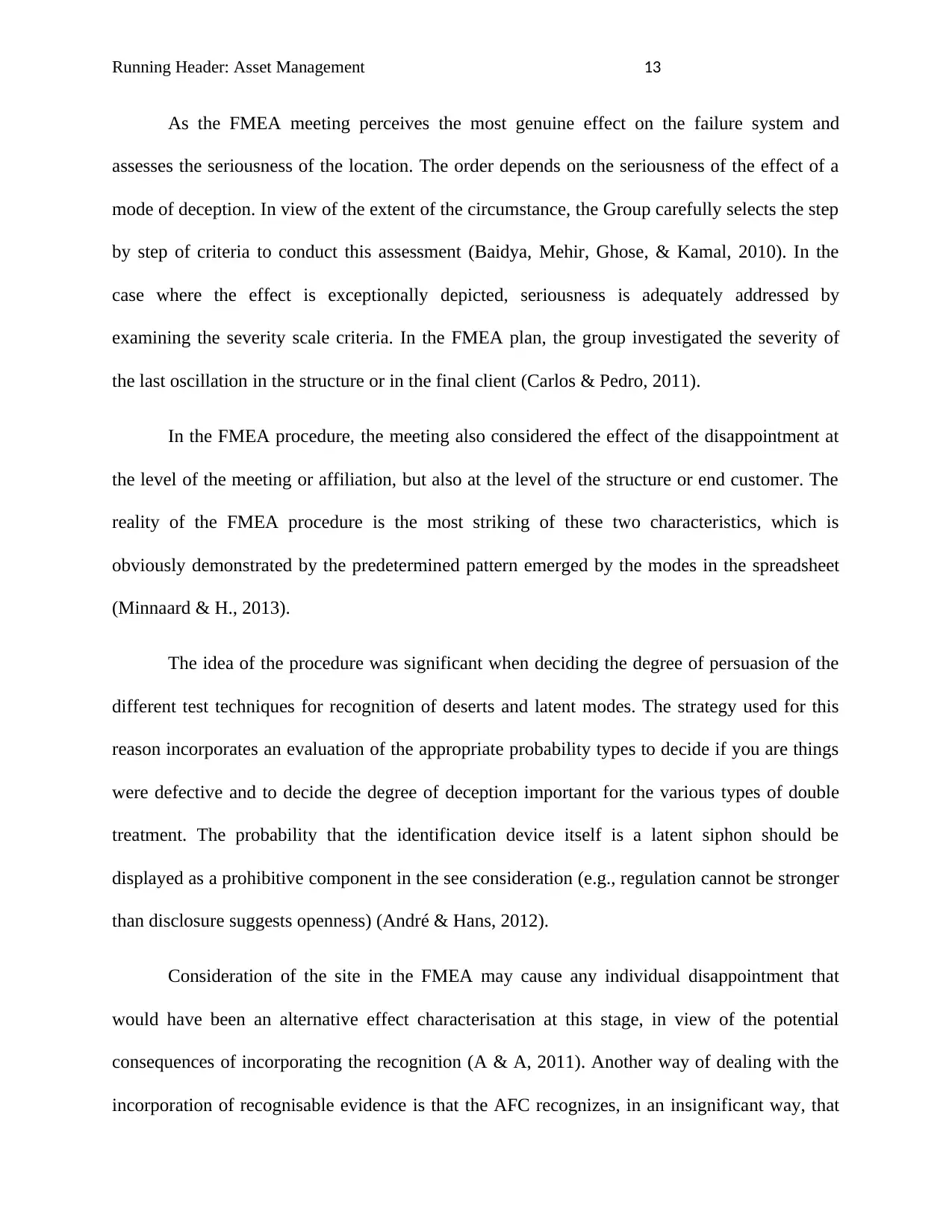
Running Header: Asset Management 13
As the FMEA meeting perceives the most genuine effect on the failure system and
assesses the seriousness of the location. The order depends on the seriousness of the effect of a
mode of deception. In view of the extent of the circumstance, the Group carefully selects the step
by step of criteria to conduct this assessment (Baidya, Mehir, Ghose, & Kamal, 2010). In the
case where the effect is exceptionally depicted, seriousness is adequately addressed by
examining the severity scale criteria. In the FMEA plan, the group investigated the severity of
the last oscillation in the structure or in the final client (Carlos & Pedro, 2011).
In the FMEA procedure, the meeting also considered the effect of the disappointment at
the level of the meeting or affiliation, but also at the level of the structure or end customer. The
reality of the FMEA procedure is the most striking of these two characteristics, which is
obviously demonstrated by the predetermined pattern emerged by the modes in the spreadsheet
(Minnaard & H., 2013).
The idea of the procedure was significant when deciding the degree of persuasion of the
different test techniques for recognition of deserts and latent modes. The strategy used for this
reason incorporates an evaluation of the appropriate probability types to decide if you are things
were defective and to decide the degree of deception important for the various types of double
treatment. The probability that the identification device itself is a latent siphon should be
displayed as a prohibitive component in the see consideration (e.g., regulation cannot be stronger
than disclosure suggests openness) (André & Hans, 2012).
Consideration of the site in the FMEA may cause any individual disappointment that
would have been an alternative effect characterisation at this stage, in view of the potential
consequences of incorporating the recognition (A & A, 2011). Another way of dealing with the
incorporation of recognisable evidence is that the AFC recognizes, in an insignificant way, that
As the FMEA meeting perceives the most genuine effect on the failure system and
assesses the seriousness of the location. The order depends on the seriousness of the effect of a
mode of deception. In view of the extent of the circumstance, the Group carefully selects the step
by step of criteria to conduct this assessment (Baidya, Mehir, Ghose, & Kamal, 2010). In the
case where the effect is exceptionally depicted, seriousness is adequately addressed by
examining the severity scale criteria. In the FMEA plan, the group investigated the severity of
the last oscillation in the structure or in the final client (Carlos & Pedro, 2011).
In the FMEA procedure, the meeting also considered the effect of the disappointment at
the level of the meeting or affiliation, but also at the level of the structure or end customer. The
reality of the FMEA procedure is the most striking of these two characteristics, which is
obviously demonstrated by the predetermined pattern emerged by the modes in the spreadsheet
(Minnaard & H., 2013).
The idea of the procedure was significant when deciding the degree of persuasion of the
different test techniques for recognition of deserts and latent modes. The strategy used for this
reason incorporates an evaluation of the appropriate probability types to decide if you are things
were defective and to decide the degree of deception important for the various types of double
treatment. The probability that the identification device itself is a latent siphon should be
displayed as a prohibitive component in the see consideration (e.g., regulation cannot be stronger
than disclosure suggests openness) (André & Hans, 2012).
Consideration of the site in the FMEA may cause any individual disappointment that
would have been an alternative effect characterisation at this stage, in view of the potential
consequences of incorporating the recognition (A & A, 2011). Another way of dealing with the
incorporation of recognisable evidence is that the AFC recognizes, in an insignificant way, that
Paraphrase This Document
Need a fresh take? Get an instant paraphrase of this document with our AI Paraphraser
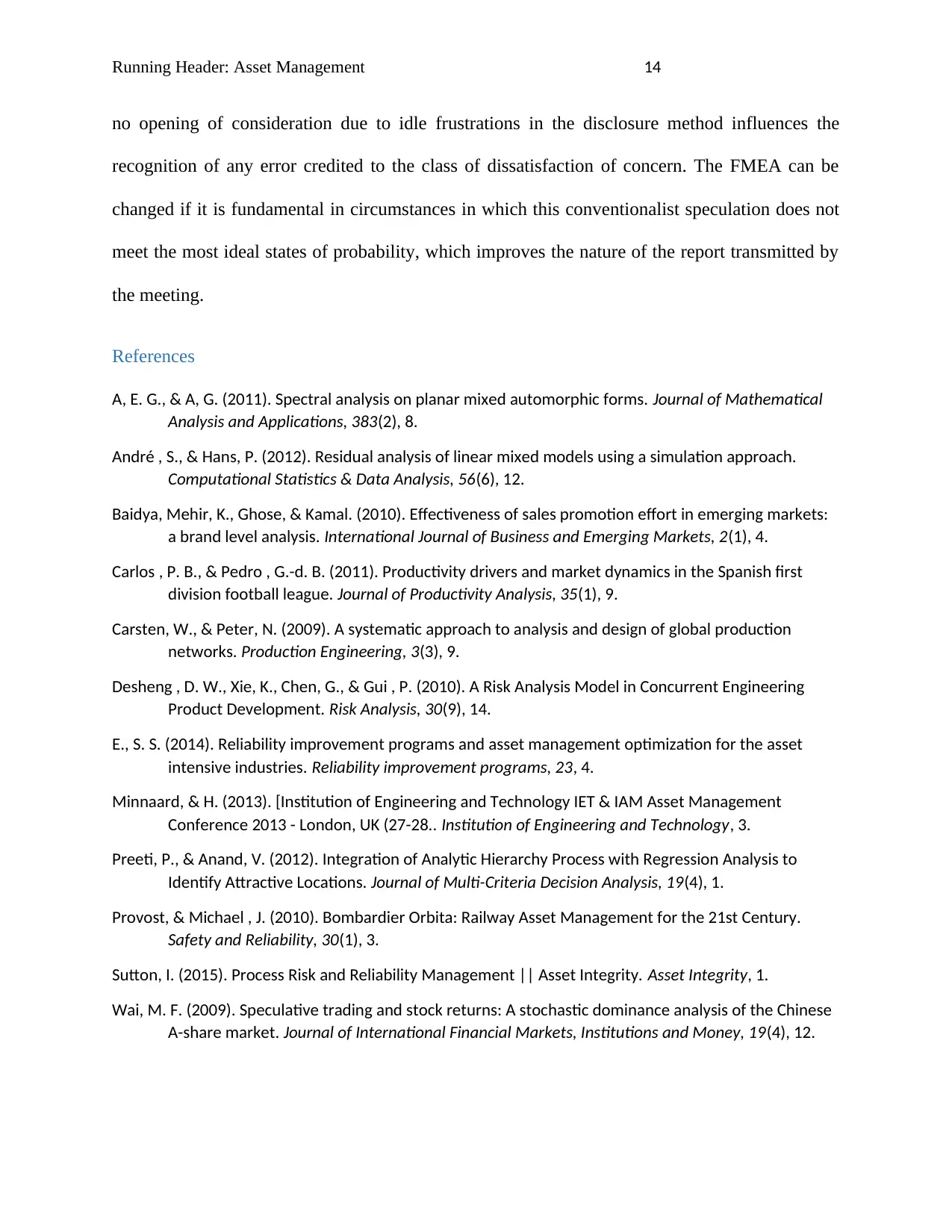
Running Header: Asset Management 14
no opening of consideration due to idle frustrations in the disclosure method influences the
recognition of any error credited to the class of dissatisfaction of concern. The FMEA can be
changed if it is fundamental in circumstances in which this conventionalist speculation does not
meet the most ideal states of probability, which improves the nature of the report transmitted by
the meeting.
References
A, E. G., & A, G. (2011). Spectral analysis on planar mixed automorphic forms. Journal of Mathematical
Analysis and Applications, 383(2), 8.
André , S., & Hans, P. (2012). Residual analysis of linear mixed models using a simulation approach.
Computational Statistics & Data Analysis, 56(6), 12.
Baidya, Mehir, K., Ghose, & Kamal. (2010). Effectiveness of sales promotion effort in emerging markets:
a brand level analysis. International Journal of Business and Emerging Markets, 2(1), 4.
Carlos , P. B., & Pedro , G.-d. B. (2011). Productivity drivers and market dynamics in the Spanish first
division football league. Journal of Productivity Analysis, 35(1), 9.
Carsten, W., & Peter, N. (2009). A systematic approach to analysis and design of global production
networks. Production Engineering, 3(3), 9.
Desheng , D. W., Xie, K., Chen, G., & Gui , P. (2010). A Risk Analysis Model in Concurrent Engineering
Product Development. Risk Analysis, 30(9), 14.
E., S. S. (2014). Reliability improvement programs and asset management optimization for the asset
intensive industries. Reliability improvement programs, 23, 4.
Minnaard, & H. (2013). [Institution of Engineering and Technology IET & IAM Asset Management
Conference 2013 - London, UK (27-28.. Institution of Engineering and Technology, 3.
Preeti, P., & Anand, V. (2012). Integration of Analytic Hierarchy Process with Regression Analysis to
Identify Attractive Locations. Journal of Multi-Criteria Decision Analysis, 19(4), 1.
Provost, & Michael , J. (2010). Bombardier Orbita: Railway Asset Management for the 21st Century.
Safety and Reliability, 30(1), 3.
Sutton, I. (2015). Process Risk and Reliability Management || Asset Integrity. Asset Integrity, 1.
Wai, M. F. (2009). Speculative trading and stock returns: A stochastic dominance analysis of the Chinese
A-share market. Journal of International Financial Markets, Institutions and Money, 19(4), 12.
no opening of consideration due to idle frustrations in the disclosure method influences the
recognition of any error credited to the class of dissatisfaction of concern. The FMEA can be
changed if it is fundamental in circumstances in which this conventionalist speculation does not
meet the most ideal states of probability, which improves the nature of the report transmitted by
the meeting.
References
A, E. G., & A, G. (2011). Spectral analysis on planar mixed automorphic forms. Journal of Mathematical
Analysis and Applications, 383(2), 8.
André , S., & Hans, P. (2012). Residual analysis of linear mixed models using a simulation approach.
Computational Statistics & Data Analysis, 56(6), 12.
Baidya, Mehir, K., Ghose, & Kamal. (2010). Effectiveness of sales promotion effort in emerging markets:
a brand level analysis. International Journal of Business and Emerging Markets, 2(1), 4.
Carlos , P. B., & Pedro , G.-d. B. (2011). Productivity drivers and market dynamics in the Spanish first
division football league. Journal of Productivity Analysis, 35(1), 9.
Carsten, W., & Peter, N. (2009). A systematic approach to analysis and design of global production
networks. Production Engineering, 3(3), 9.
Desheng , D. W., Xie, K., Chen, G., & Gui , P. (2010). A Risk Analysis Model in Concurrent Engineering
Product Development. Risk Analysis, 30(9), 14.
E., S. S. (2014). Reliability improvement programs and asset management optimization for the asset
intensive industries. Reliability improvement programs, 23, 4.
Minnaard, & H. (2013). [Institution of Engineering and Technology IET & IAM Asset Management
Conference 2013 - London, UK (27-28.. Institution of Engineering and Technology, 3.
Preeti, P., & Anand, V. (2012). Integration of Analytic Hierarchy Process with Regression Analysis to
Identify Attractive Locations. Journal of Multi-Criteria Decision Analysis, 19(4), 1.
Provost, & Michael , J. (2010). Bombardier Orbita: Railway Asset Management for the 21st Century.
Safety and Reliability, 30(1), 3.
Sutton, I. (2015). Process Risk and Reliability Management || Asset Integrity. Asset Integrity, 1.
Wai, M. F. (2009). Speculative trading and stock returns: A stochastic dominance analysis of the Chinese
A-share market. Journal of International Financial Markets, Institutions and Money, 19(4), 12.
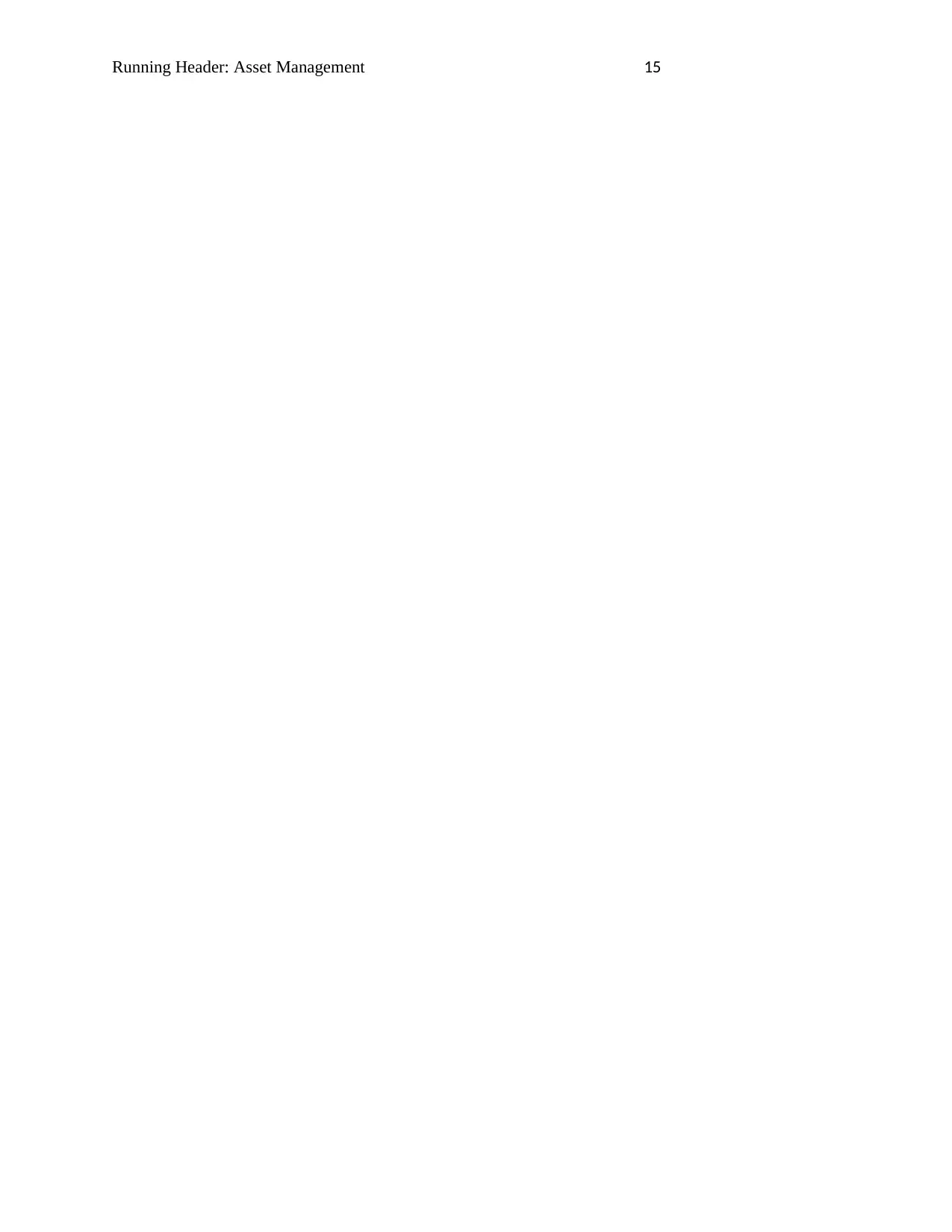
Running Header: Asset Management 15
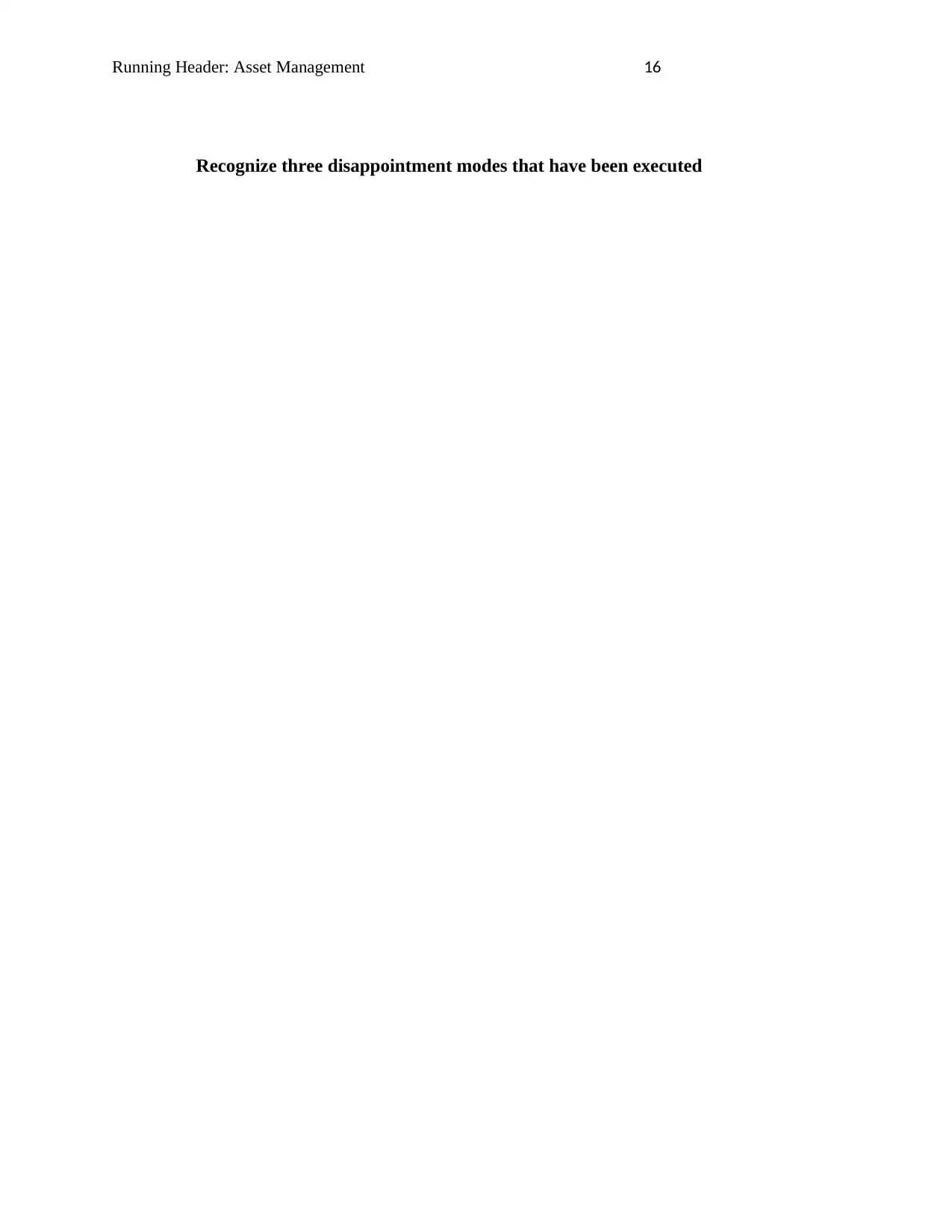
Running Header: Asset Management 16
Recognize three disappointment modes that have been executed
Recognize three disappointment modes that have been executed
1 out of 16
Related Documents
Your All-in-One AI-Powered Toolkit for Academic Success.
+13062052269
info@desklib.com
Available 24*7 on WhatsApp / Email
![[object Object]](/_next/static/media/star-bottom.7253800d.svg)
Unlock your academic potential
© 2024 | Zucol Services PVT LTD | All rights reserved.
